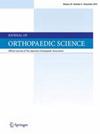锁骨钩钢板与 Scorpion Plate® 治疗不稳定锁骨远端骨折的临床疗效和放射影像比较。
IF 1.4
4区 医学
Q3 ORTHOPEDICS
引用次数: 0
摘要
背景:尽管目前有多种手术方法可用于治疗不稳定型锁骨远端骨折,但对于最佳技术仍缺乏共识。因此,本回顾性研究旨在比较锁骨钩钢板和 Scorpion Plate® 治疗不稳定型锁骨远端骨折的临床效果和放射学结果:57名不稳定锁骨远端骨折患者接受了锁骨钩钢板(H组,28名患者)或Scorpion Plate®(S组,29名患者)治疗。所有患者均接受了 1 年以上的随访(平均随访时间为 28 个月)。临床结果包括手术时间、出血量、并发症、术后6个月和最终随访时的活动范围(ROM)以及临床评分(Constant-Murley评分和加州大学洛杉矶分校(UCLA)肩关节评分)。评估的放射学结果包括X光片显示的肩锁关节间距(CCD)、患侧与非患侧肩锁关节间距的差异(ΔCCD)和肩锁关节脱位率(%ACS)。采用χ2检验和Mann-Whitney U检验比较各项结果:H组有3个肩关节(10.7%)出现并发症。术后 6 个月时,H 组的 ROM 明显降低,但在最终随访时,组间无明显差异。此外,组间的临床结果也无明显差异。在放射学结果方面,H组的CCD和ΔCCD改善程度高于S组:结论:锁骨钩钢板比蝎子钢板能重建更符合解剖学的位置,但并发症风险更大。相反,Scorpion Plate® 的并发症风险较低,但肩锁关节脱位仍然存在。不过,在最终的随访中,关节活动度或临床结果并无明显差异。本文章由计算机程序翻译,如有差异,请以英文原文为准。
Comparative clinical outcomes and radiological images of clavicle hook plate versus Scorpion Plate® for unstable distal clavicle fractures
Background
Although various surgical methods are available for unstable distal clavicle fractures, consensus remains lacking on the optimal technique. Therefore, the present retrospective study aimed to compare the clavicle hook plate and Scorpion Plate® in terms of clinical outcomes and radiological findings for unstable distal clavicle fractures.
Methods
Fifty-seven patients with unstable distal clavicle fractures who underwent treatment using a clavicle hook plate (Group H; 28 patients) or Scorpion Plate® (Group S; 29 patients) were included in the present study. No patients received additional augmentation and all were followed-up for >1 year (mean follow-up, 28 months). Clinical outcomes were operation time, bleeding volume, complications, range of motion (ROM) at 6 months after surgery and final follow-up, and clinical scores (Constant–Murley score and University of California, Los Angeles (UCLA) shoulder score). Radiological outcomes assessed were coracoclavicular distance (CCD), difference in CCD between affected and non-affected sides (ΔCCD), and acromioclavicular subluxation ratio (%ACS) from plain X-rays. The χ2 test and Mann–Whitney U test were used to compare each outcome.
Results
Complications were seen in 3 shoulders (10.7%) in Group H. ROM was significantly worse in Group H at 6 months postoperatively, but no significant differences between groups were evident at final follow-up. Moreover, no significant differences in clinical outcomes were seen between groups. In terms of radiological results, Group H showed greater improvement in CCD and ΔCCD than Group S. Further, %ACS was significantly worse in Group S.
Conclusions
The clavicle hook plate allows reconstruction of a more anatomical position than the Scorpion Plate®, but carries a greater risk of complications. Conversely, the Scorpion Plate® has a low risk of complications, but acromioclavicular subluxation remains. However, no significant differences in ROM or clinical outcomes were apparent at final follow-up.
求助全文
通过发布文献求助,成功后即可免费获取论文全文。
去求助
来源期刊

Journal of Orthopaedic Science
医学-整形外科
CiteScore
3.00
自引率
0.00%
发文量
290
审稿时长
90 days
期刊介绍:
The Journal of Orthopaedic Science is the official peer-reviewed journal of the Japanese Orthopaedic Association. The journal publishes the latest researches and topical debates in all fields of clinical and experimental orthopaedics, including musculoskeletal medicine, sports medicine, locomotive syndrome, trauma, paediatrics, oncology and biomaterials, as well as basic researches.
 求助内容:
求助内容: 应助结果提醒方式:
应助结果提醒方式:


